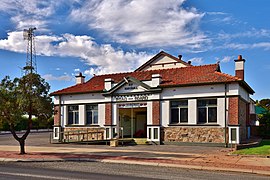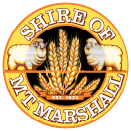| Shire of Mount Marshall Western Australia | |||||||||||||||
|---|---|---|---|---|---|---|---|---|---|---|---|---|---|---|---|
 Mount Marshall Shire Hall, Bencubbin, 2018 | |||||||||||||||
 Location in Western Australia | |||||||||||||||
 | |||||||||||||||
| Population | 459 (LGA 2021)[1] | ||||||||||||||
| • Density | 0.06/km2 (0.16/sq mi) | ||||||||||||||
| Established | 1923 | ||||||||||||||
| Area | 10,189.5 km2 (3,934.2 sq mi) | ||||||||||||||
| Shire President | Tony Sachse | ||||||||||||||
| Council seat | Bencubbin | ||||||||||||||
| Region | Wheatbelt | ||||||||||||||
| State electorate(s) | Central Wheatbelt | ||||||||||||||
| Federal division(s) | Durack | ||||||||||||||
 | |||||||||||||||
| Website | Shire of Mount Marshall | ||||||||||||||
| |||||||||||||||
The Shire of Mount Marshall is a local government area in the Wheatbelt region of Western Australia, about 80 kilometres (50 mi) north-northwest of Merredin and about 300 kilometres (186 mi) northeast of the state capital, Perth. The Shire covers an area of 10,190 square kilometres (3,934 sq mi), and its seat of government is the town of Bencubbin.
History
[edit]The first European explorer in the area was Surveyor General John Septimus Roe; Mount Marshall and Lake McDermott were named after early Swan River Colony settler Marshall McDermott, cashier of the Bank of Western Australia, magistrate, and a director of the Agricultural Society of Western Australia.[2][3][4] The area was first settled by sandalwood collectors and graziers in 1868. Sandalwood was removed from this area from the 1880s until the 1920s. Permanent settlement and the development and clearing of the land for farms commenced around 1910.
The Mount Marshall Road District was established on 6 July 1923 from areas formerly falling within the Ninghan Road District and Nungarin Road District. On 1 July 1961, it became a shire following the passage of the Local Government Act 1960, which reformed all remaining road districts into shires.[5]
Wards
[edit]The Shire has no wards and each Councillor represents the entire district of the Shire of Mt Marshall as required by the Local Government Act 1995.
Towns and localities
[edit]The towns and localities of the Shire of Mount Marshall with population and size figures based on the most recent Australian census:[6][7]
| Locality | Population | Area | Map |
|---|---|---|---|
| Beacon | 123 (SAL 2021)[8] | 701.3 km2 (270.8 sq mi) | 
|
| Bencubbin | 203 (SAL 2021)[9] | 688 km2 (266 sq mi) | 
|
| Bimbijy | 0 (SAL 2016)[10][11] | 880.7 km2 (340.0 sq mi) | 
|
| Cleary | 3 (SAL 2021)[12] | 398.4 km2 (153.8 sq mi) | 
|
| Gabbin | 44 (SAL 2021)[13] | 806.9 km2 (311.5 sq mi) | 
|
| Karroun Hill | 0 (SAL 2016)[14][15] | 2,814.2 km2 (1,086.6 sq mi) | 
|
| Mouroubra | 0 (SAL 2016)[16][17] | 1,311.5 km2 (506.4 sq mi) | 
|
| Remlap | 0 (SAL 2016)[18][19] | 717 km2 (277 sq mi) | 
|
| Tampu | 18 (SAL 2021)[20] | 576.5 km2 (222.6 sq mi) | 
|
| Welbungin | 35 (SAL 2021)[21] | 875.3 km2 (338.0 sq mi) | 
|
| Wialki * | 45 (SAL 2021)[22] | 889.1 km2 (343.3 sq mi) | 
|
- (* indicates locality is only partially located within this shire)
Heritage-listed places
[edit]As of 2023, 50 places are heritage-listed in the Shire of Mount Marshall,[23] of which none are on the State Register of Heritage Places.[24]
References
[edit]- ^ Australian Bureau of Statistics (28 June 2022). "Mount Marshall (Local Government Area)". Australian Census 2021 QuickStats. Retrieved 28 June 2022.
- ^ "Public meeting". The Perth Gazette and Western Australian Journal. 9 January 1836. p. 630. Retrieved 19 October 2020.
- ^ "The Swan River Guardian". No. 57. Perth, WA. 4 January 1838. p. 176. Retrieved 19 October 2020.
- ^ "Government Notice". The Perth Gazette and Western Australian Journal. No. 259. 16 December 1837. p. 1032. Retrieved 19 October 2020.
- ^ "Municipality Boundary Amendments Register" (PDF). Western Australian Electoral Distribution Commission. Retrieved 11 January 2020.
- ^ "SLIP Map". maps.slip.wa.gov.au. Landgate. Retrieved 10 February 2023.
- ^ "NationalMap". nationalmap.gov.au. Geoscience Australia. Retrieved 10 February 2023.
- ^ Australian Bureau of Statistics (28 June 2022). "Beacon (suburb and locality)". Australian Census 2021 QuickStats. Retrieved 28 June 2022.
- ^ Australian Bureau of Statistics (28 June 2022). "Bencubbin (suburb and locality)". Australian Census 2021 QuickStats. Retrieved 28 June 2022.
- ^ Australian Bureau of Statistics (27 June 2017). "Bimbijy (suburb and locality)". Australian Census 2016.
- ^ Australian Bureau of Statistics (27 June 2017). "Bimbijy (suburb and locality)". Australian Census 2016 QuickStats. Retrieved 28 June 2022.
- ^ Australian Bureau of Statistics (28 June 2022). "Cleary (suburb and locality)". Australian Census 2021 QuickStats. Retrieved 28 June 2022.
- ^ Australian Bureau of Statistics (28 June 2022). "Gabbin (suburb and locality)". Australian Census 2021 QuickStats. Retrieved 28 June 2022.
- ^ Australian Bureau of Statistics (27 June 2017). "Karroun Hill (suburb and locality)". Australian Census 2016.
- ^ Australian Bureau of Statistics (27 June 2017). "Karroun Hill (suburb and locality)". Australian Census 2016 QuickStats. Retrieved 28 June 2022.
- ^ Australian Bureau of Statistics (27 June 2017). "Mouroubra (suburb and locality)". Australian Census 2016.
- ^ Australian Bureau of Statistics (27 June 2017). "Mouroubra (suburb and locality)". Australian Census 2016 QuickStats. Retrieved 28 June 2022.
- ^ Australian Bureau of Statistics (27 June 2017). "Remlap (suburb and locality)". Australian Census 2016.
- ^ Australian Bureau of Statistics (27 June 2017). "Remlap (suburb and locality)". Australian Census 2016 QuickStats. Retrieved 28 June 2022.
- ^ Australian Bureau of Statistics (28 June 2022). "Tampu (suburb and locality)". Australian Census 2021 QuickStats. Retrieved 28 June 2022.
- ^ Australian Bureau of Statistics (28 June 2022). "Welbungin (suburb and locality)". Australian Census 2021 QuickStats. Retrieved 28 June 2022.
- ^ Australian Bureau of Statistics (28 June 2022). "Wialki (suburb and locality)". Australian Census 2021 QuickStats. Retrieved 28 June 2022.
- ^ "Shire of Mount Marshall Heritage Places". inherit.stateheritage.wa.gov.au. Heritage Council of Western Australia. Retrieved 25 February 2023.
- ^ "Shire of Mount Marshall State Register of Heritage Places". inherit.stateheritage.wa.gov.au. Heritage Council of Western Australia. Retrieved 25 February 2023.